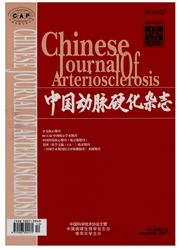

 中文摘要:
中文摘要:
目的观察促红细胞生成素(EPO)对血管紧张素Ⅱ(AngⅡ)诱导培养的乳鼠心脏成纤维细胞(cF)表型转化的影响,以及其可能的信号通路(TGF-β1-TAK1-p38MAPK)在其中的作用。方法体外分离培养乳鼠心脏成纤维细胞,用10μmol/L的Angll诱导培养心脏成纤维细胞表型转化,加入20kU/L的EPO进行预干预,同时加或不加15la,mol/L的SB203580进行处理,以平滑肌肌动蛋白(SMA)表达作为心脏成纤维细胞表型转化的观察指标,应用免疫组织化学观察心脏成纤维细胞内SMA表达情况;采用实时荧光定量PCR方法检测细胞内信号分子转化生长因子β1(TGF-β1)及p38丝裂原活化蛋白激酶(p38MAPK)mRNA的表达情况;采用蛋白免疫印迹法检测α平滑肌肌动蛋白(α-SMA)、TGF-β1、转化生长因子激活性激酶1(TAKl)、p38MAPK以及磷酸化的TAKl(p-TAKl)和p-p38MAPK的表达情况。结果20kU/L的EPO能有效抑制Ang1I诱导的CF细胞表型转化,减少cF细胞内Ct—SMA蛋白的沉积,降低cF表型转化相关信号分子TGF.Bl、p-TAKl、TAKl、p-p38MAPK和p38MAPK的活化或表达,且加入SB203580后该作用增强。结论EPO可抑制AnglI诱导的乳鼠心脏成纤维细胞表型转化为肌成纤维细胞,减轻心肌纤维化,并可降低相关信号分子mRNA及蛋白的表达,初步考虑EPO抑制心肌纤维化,减轻心室重构的作用是通过TGF-β1-TAK1-p38MAPK进行的。
 英文摘要:
英文摘要:
Aim To observe the effects of erythropoietin (EPO) on neonatal rat cardiac fibrosis phenotypic switched into myofibroblasts induced by angiotensin Ⅱ ( AngⅡ ) and the association with possible signaling pathway ( tran sforming growth factor-beta1 (TGF-β1)-TGF-β1-activated kinase-1 (TAK1)-mitogen-activated protein kinase(p38MAPK) ). Methods Cardiac fibroblasts were isolated from new-born Sprague-Dawley rats, and the cells were used to establish the model of fibrosis by Ang II (10.6 tool/L) in vitro. Then they were treated with EPO(20 kU/L) ,at the same time,they were treated with or without the p38MAPK inhibitor SB203580 ( 15 I.umol/L). Immunohistochemistry was used to detect the intraeellular protein expression of α-smooth muscle aetin(cx-SMA). The mRNA levels of TGF-β1 and p38MAPK was analyzed by quantitative real-time PCR. The protein expression of α-SMA,TGF-β1, TAKI, and p38MAPK and the phos- phorylation of TAK1 and p38MAPK were analyzed by Western blot. Results 20 kU/L of EPO can effectively inhibit Ang II-induced cardiac phenotypie switched into myofibroblasts, reduce the intraeellular protein expression of s-smooth muscle actin (et-SMA), and also can significantly suppress AngII-induced upregulation of TGF-β1, TAKt, and p38MAPK expression and phosphrylation of TAK1 and p38MAPK. The effects can be strengthened by SB203580. Conclusion EPO can effectively inhibit Ang 1I -induced cardiac phenotypic switched into myofibroblasts, reduce myocardial fibrosis, and can reduce the related signaling molecules mRNA and protein expression. Preliminary consideration of the EPO can inhib- it myocardial fibrosis, reduce the process of ventricular remodeling through TGF-TAKl -p38MAPK.
 同期刊论文项目
同期刊论文项目
 同项目期刊论文
同项目期刊论文
 期刊信息
期刊信息
